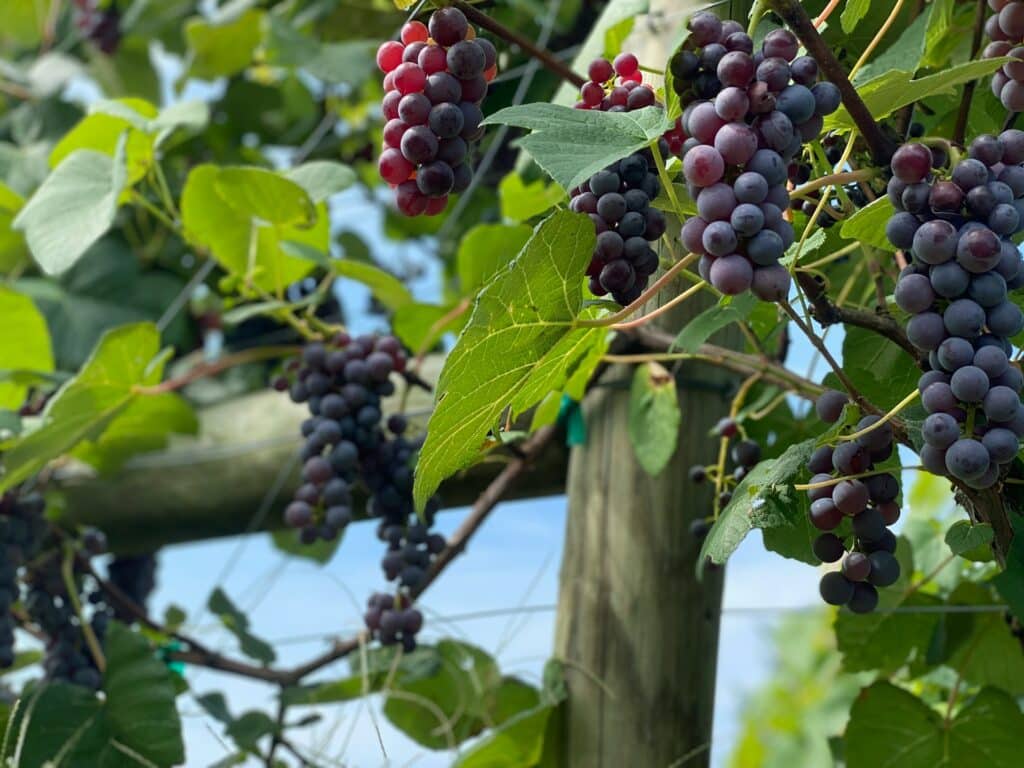The vine, a multi-faceted noble plant, follows a fascinating annual cycle that culminates in the production of those precious fruits: grapes.

Understanding this cycle is essential for every wine lover, as it directly influences the quality and character of the nectar we taste.
Let’s immerse ourselves in this seasonal dance that punctuates the life of the vineyards.
1/ Winter rest: dormancy
After the harvest and leaf fall, the vine enters a resting phase called dormancy. From November to February, it appears to be asleep, but in reality, it’s building up reserves for the coming spring. This is also the time when winegrowers prune the vines, in preparation for the coming harvest.
2/ Spring awakening: budburst
As soon as temperatures rise again, usually in March or April, the sap starts to circulate again. This is budburst: the buds swell and burst, revealing small leaves. This is a crucial and delicate moment, as a late frost can compromise the future harvest.
3/ Growth: flowering and fruit set
Between May and June, depending on the region and grape variety, the flowers of the vine appear. These tiny flowers, grouped in clusters, are the prelude to the grapes of the future. Flowering is followed by fruit set, when the fertilized flowers turn into tiny green berries.
4/ Fruit development: veraison
It’s in July that the miracle really begins. The bunches form and the grapes begin to swell. Then comes veraison, when the grapes change color. Red varieties turn from green to reddish-purple, while whites take on a golden or translucent hue. It’s also at this stage that the grapes begin to accumulate sugar.
5/ Maturation: waiting for the perfect balance
From August to September (or even October for certain late-ripening grape varieties), the grapes continue to ripen. They gain sugar, lose acidity, and develop their characteristic aromas. Winemakers keep a close eye on this phase, carrying out regular checks to determine the ideal moment for harvesting.
6/ The climax: the grape harvest
Finally comes the long-awaited moment of harvest. Whether harvested by hand or by machine, it’s the culmination of a year’s work and waiting. Timing is crucial: harvesting too early can produce acidic, unexpressive wines, while harvesting too late can produce heavy, alcoholic wines.
Summary table :
| Step | Period | Description | Interesting info |
|---|---|---|---|
| Sleep | November – February | Winter rest, pruning | The vines can withstand temperatures as low as -20°C. |
| Budburst | March – April | Bud break | The vine “cries”: sap flows from pruning wounds |
| Flowering and Setting | May – June | Flowers appear, berries form | A vine can produce up to 1 million flowers |
| Veraison | July – August | Grapes change color | Birds are attracted by coloured grapes, requiring protection measures |
| Maturation | August – September | Sugar accumulation, aroma development | The vine slows down its vegetative growth to concentrate its energy on fruit. |
| Harvest | September – October | Grape harvest |
Factors influencing the cycle
Several factors can affect this cycle and therefore the moment when the vine produces grapes:
- Climate: A cold spring will delay budburst, while a hot summer can speed up ripening. That’s why Ventigel helps you fight the cold!
- Grape variety: Some varieties are early, others late.
- Terroir: Exposure, soil and microclimate play a crucial role.
- Vine-growing practices: pruning, irrigation and foliage management all influence vine development.
Conclusion
The vine produces grapes at the end of a long process that extends over several months. From winter dormancy to autumn harvest, each stage is crucial in shaping the character of the future wine. Understanding this cycle allows us not only to appreciate the colossal efforts of our winemakers, but also to better grasp the subtleties of each vintage.
The next time you enjoy a glass of wine, take a moment to reflect on the extraordinary journey, from bud to grape, that made this moment of pleasure possible.

